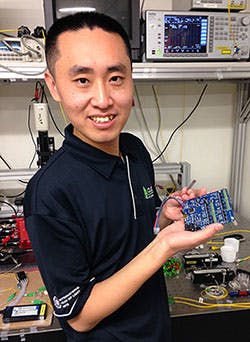University of Sydney CUDOS team demonstrates quantum communications on a chip
Phones and computers are a step closer to being more secure thanks to physicists from the University of Sydney that have developed a photonic chip able to communicate information more securely and small enough to fit most computers. The team is from the Centre of Excellence for Ultrahigh bandwidth Devices for Optical Systems (CUDOS), who developed the chip for the process of photonic entanglement. Considered the holy grail of long-distance secure communication, the CUDOS team says that photonic entanglement has never before been demonstrated on a chip small enough to fit a computer.
RELATED ARTICLE: Quantum entanglement physics secures space-to-space interferometric communications
"This development paves the way to explore a new platform for implementing integrated quantum photonic technologies for secure communication on personal phones and computers," said Chunle Xiong, who led the research, published in Optica.
The chip exploits the properties of quantum mechanics (entangled photons), the basis for secure networks. Photonic entanglement links the quantum states of photons even if they are sent separately to distant locations. Changes made to one photon will result in corresponding changes to its partner photon due to the entanglement. This makes it possible to send quantum information without disclosing it to other parties during communication, making transmission secure. Previous demonstrations of this process relied on bulky components unable to be easily integrated with personal phones or computers.
"We demonstrated, for the first time, the time-bin preparation, photon separation and entanglement analysis on a monolithic photonic chip," said Xiong. "The major challenge is to achieve sophisticated low-loss photonic circuits and device compactness simultaneously. We overcame this by using a silicon nitride photonic circuit, combining the low-loss characteristic of silica and tight integration features of silicon." The photonic chip also serves as an entanglement analyzer to monitor the security of communications using entangled photons.
CUDOS director and co-author professor Ben Eggleton said this major breakthrough for quantum technologies is more satisfying because of the collaboration involved. "It builds on a highly successful collaboration between Physics, and Electrical and Information Technology at the University of Sydney. We are starting to integrate sophisticated electronics with our photonic circuits, opening the way for many exciting opportunities."
SOURCE: University of Sydney; http://www.cudos.org.au/news/2015-08-06_Chunle.shtml
About the Author

Gail Overton
Senior Editor (2004-2020)
Gail has more than 30 years of engineering, marketing, product management, and editorial experience in the photonics and optical communications industry. Before joining the staff at Laser Focus World in 2004, she held many product management and product marketing roles in the fiber-optics industry, most notably at Hughes (El Segundo, CA), GTE Labs (Waltham, MA), Corning (Corning, NY), Photon Kinetics (Beaverton, OR), and Newport Corporation (Irvine, CA). During her marketing career, Gail published articles in WDM Solutions and Sensors magazine and traveled internationally to conduct product and sales training. Gail received her BS degree in physics, with an emphasis in optics, from San Diego State University in San Diego, CA in May 1986.
